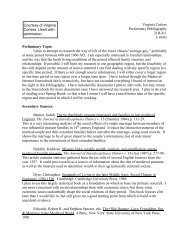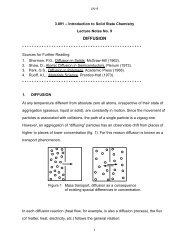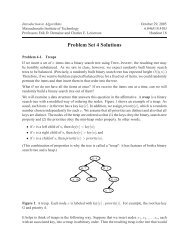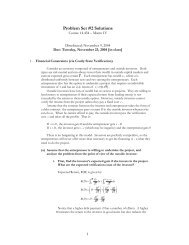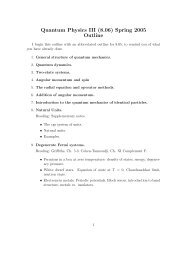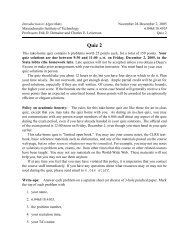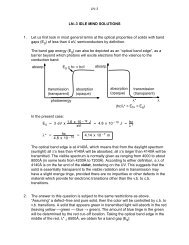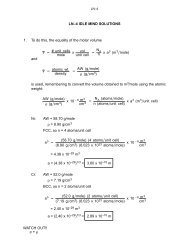3.091 â Introduction to Solid State Chemistry Lecture Notes No. 2 ...
3.091 â Introduction to Solid State Chemistry Lecture Notes No. 2 ...
3.091 â Introduction to Solid State Chemistry Lecture Notes No. 2 ...
- No tags were found...
Create successful ePaper yourself
Turn your PDF publications into a flip-book with our unique Google optimized e-Paper software.
LN–2The energetics associated with ionic bond formation may be determined quantitativelyby considering the energy changes associated with the individual steps leading fromthe starting materials <strong>to</strong> the final product (Haber-Born cycle).The bond formation in NaCl may be formally presented as an electron-transfer reaction:1e–Na + Cl → Na + + Cl –The reactions involved in this process which result in the formation of 1 mole of solidsalt are:(1) Ionization of Na:Na (gas) → Na + + 1e(E.I. = +497 kJ/mole)The energy change associated with this step, energy of ionization (E.I.), is+497 kJ/mole.(2) Acquisition of one electron by Cl:Cl (gas) + 1e → Cl –(E.A. = –364 kJ/mole)The energy change associated with this step, electron affinity (E.A.), is–364 kJ/mole. The minus sign reflects an energy release, a lowering of the energystate associated with the achievement of stable rare gas configuration by chlorine.So far, the energy balance appears positive (ΔE = +133 kJ); this means the reaction isnot favored since the final products are at a higher energy state than the startingproducts. However, there are additional steps involved since:(3) Vaporization of Na:Na (metal) → Na (gas)(ΔH V = +109 kJ/mole)The energy required <strong>to</strong> transform Na (metal) in<strong>to</strong> Na (gas), the latent heat ofvaporization (ΔH V ), is 109 kJ/mole (now reaction appears even less favorable).7
LN–2(4) Dissociation of Cl2:Cl 2 → 2Cl(E.D. = +242 kJ)The energy associated with breaking up the (stable) chlorine molecule in<strong>to</strong> tworeactive chlorine a<strong>to</strong>ms, dissociation energy (E.D.), is +242 kJ/mole. (Since theformation of one mole NaCl involves only 1 mole Cl, and since 2 moles are formedfrom one mole Cl 2 , the energy required in this step is 1/2 E.D., or 121 kJ.)The <strong>to</strong>tal energy change associated with reactions (1) through (4), ΔH T = +364 kJ Thisindicates that one or more basic reactions which lead <strong>to</strong> an overall decrease in energyare still unconsidered.(5) Unconsidered as yet is the coulombic attraction of the reaction products which areof opposite charge and an energy term associated with the formation of the “solidstate” product, NaCl. The two ionic species, originally at zero energy (infinitedistance of separation), attract each other with an accompanying energy change(decrease).The energetics associated with the approach of the reaction partners (fig. 3) is bestconsidered by fixing the position of one, for example Na + , and letting the other (Cl – )approach: as Cl – approaches Na + , E decreases according <strong>to</strong> Coulomb’s law withe 2 /4πε o r. With the approach of the two oppositely charged ions, the outermostelectronic shells will come in<strong>to</strong> contact and a repulsive force will become active as theshells interpenetrate. The repulsive force (E rep ) increases with +b/r 12 and thus is onlyactive in the immediate vicinity of the sodium ion, but at that stage increases rapidly.The two ions at close proximity are under the influence of both attractive and repulsiveforces and will assume a distance of separation at which the two forces balance eachother - a distance which is referred <strong>to</strong> as the equilibrium separation (r o ) and which8
LN–2(+)Erep = b/rnE coulcation0+AnionE<strong>to</strong>tal = Eattr + Erep(r)"BondEnergy"Eattr = - e2/4πε ο rEo(-)roequilibrium distance of separation (ro)at Energy minimum (Bond energy)Figure 3 Energetics of ionic bonding.corresponds <strong>to</strong> the energy minimum for the NaCl molecules:E +*e 2)bcoul4peo r o r 12owhere e = electronic charge, ε o = permittivity of free space (8.85 x 10 –12 F/m) and (b) isa constant. (r o for gaseous molecules may be obtained from physical measurements.)If the presently considered coulombic (attractive) energy term is taken in<strong>to</strong>consideration as reaction (5), it will decrease the overall positive energy change, ΔH T ; itwill, however, not make it change sign from (+) <strong>to</strong> (–). Thus, NaCl molecules in gaseousform are not the final reaction product; nor would reaction occur if ΔH T remainedpositive.Considering an ionically bonded, gaseous Na + Cl – molecule, it is clear that itselectrostatic forces (+) and (–) are not saturated - they remain active in all possibledirections. This means that Cl – will attract Na + ions from other directions as will the Na +9
LN–2a<strong>to</strong>ms attract additional Cl – ions. The result of these attractive forces in all directions isthe formation of a “giant size” ionic body - a “solid” body of macroscopic dimensions.From the preceding it is recognized that the minimum energy configuration is given by abody in which Na + and Cl – are arranged with extreme periodicity and order since anyion located outside of its “equilibrium position” will be in a “higher energy configuration”;such an ordered body is referred <strong>to</strong> as a crystalline solid, or frequently just called asolid (fig. 2).The <strong>to</strong>tal energy change associated with the formation of one mole of crystalline ionicsolid from its ionic constituents is given as:A + * M N e2 (Q 1Q 2) 1 * 1 Ecryst 4pe o r onwhere M = 1.747 (“Madelung” constant for NaCl, reflecting multiple interactions for theparticular geometric arrangement of ions in the solid), N A = Avogadro’s number, Q =number of charges per ion (1 for Na + and Cl – ), r o = equilibrium distance of separation ofions, and n = repulsive exponent (n = 12 for NaCl).[The relationship for the crystal energy (ΔE cryst ) is readily obtained from equilibriumenergy considerations:E +* e 2coul) b4peo r 4peor nAt equilibrium distance of ion separation (r o ), (dE/dr) = 0. Thus:anddE + e 2 * nb + 0dr ro4pe o r 2 4pe o r n)1oob +e 2 r n*1 onand10
LN–2E +* e 2o(Coul)) e 24pe o r o n4pe o r oE o(Coul)+* e 21 * 1 4pe o r onFor a “molar” crystal with ionic charges Q 1 and Q 2 , the molar ΔE o(Coul) is thus given as:+* MN AQ 1Q 2eDE 2 * 1 cryst1 4pe o r onHere M and N A stand, as indicated above, for the conventional terms, the Madelungconstant and Avogadro’s number.]For the present system (NaCl):ΔE cryst = –777 kJ/mole.<strong>No</strong>w considering reactions (1) through (5):ΔH Total = –414 kJ/molewhich is identical with the value experimentally determined and given for the reaction:Na (metal) + Cl 2 (gas) ! NaCl (solid)ΔH Reaction = –414 kJ/moleIn the Haber-Born cycle, the reaction energy (ΔH) associated with the formation of NaClfrom Na + Cl 2 may be summarized as:ΔH = E.I. + E.A. + ΔH V + 1/2 E.D. + ΔH crystΔH, the heat of reaction, may thus be obtained from the energetics of the steps leading<strong>to</strong> the end product. In most instances, however, the reaction energy (ΔH) is determinedexperimentally in a calorimeter and the Haber-Born cycle is used <strong>to</strong> obtain the value ofΔE cryst or E.A., which are both extremely hard <strong>to</strong> come by.11
LN–2Conclusions: A primary drive for a<strong>to</strong>mic interactions leading <strong>to</strong> “bonding” is theachievement of valence shell octets which exhibit a high degree of stability. If a<strong>to</strong>ms onthe left and right side of the Periodic Table interact, i.e. a<strong>to</strong>ms with a large difference inelectron affinity (ΔE.A.), stabilization is achieved by electron octet formation throughcharge transfer. The reaction products exhibit opposite charges ( cations, anions)and are subject <strong>to</strong> Coulombic attraction – ionic bonds are formed. Since theelectrostatic forces are non-directional and non-saturated, energy minimization willresult in the formation of macroscopic bodies that are highly ordered on the a<strong>to</strong>micscale, crystalline ionic solids. Ionic solids have mostly predictable, basic properties:• a<strong>to</strong>mic arrangements are a function of the ion size ratio, the charge ratio of ions,and their electronic structure;• electrical and thermal conductivities are expected <strong>to</strong> be low because the highstability of the octets formed results in bound electrons which do not contribute <strong>to</strong>conduction (there is a large “energy gap” <strong>to</strong> be crossed for electrons <strong>to</strong> movein<strong>to</strong> a higher energy state);• optically, ionic solids are mostly transparent, or translucent, reflecting octetstability of the electrons and macro- or micro-crystallinity;• melting points are high, increasing with the electronic charges on the cations andanions;• ionic solids are normally hard and brittle.3. COVALENT BONDINGWave Mechanical Concepts and ConclusionsIn 1924 L. DeBroglie advanced the hypothesis that all matter in motion possesses waveproperties and can be attributed a particle wavelengthλ P = h/mvwhere h is the Planck constant, m is the mass of the matter and v is its velocity.12
LN–2The credibility of this hypothesis was established by Davisson and Germer in 1927when they demonstrated that electrons (like electromagnetic radiation) are diffracted bycrystal lattices. An important consequence of the dual nature of matter (it exhibits bothparticle and wave properties) is the uncertainty principle established in 1927 byW. Heisenberg. It states that it is impossible <strong>to</strong> simultaneously know with certainty boththe momentum and position of a moving particle:(Dp x )(Dx) } hWe can paraphrase the uncertainty principle in the following manner: If the energy of aparticle is known (measured) with high precision, its location is associated with a highdegree of uncertainty.If electrons occupied simple orbits (as postulated by Bohr-Sommerfeld), theirmomentum and position could be determined exactly at any moment - in violation ofthe uncertainty principle. According <strong>to</strong> Heisenberg, if the energy of an electron isspecified with precision (sharpness of spectral lines), its location can only be specifiedin terms of the probability of finding this electron in a certain location (volumeelement). These arguments give rise <strong>to</strong> the concepts of probability density and electroncloud which are inherent <strong>to</strong> the wave-mechanical electron concept emanating from thesolutions of Schrödinger’s wave equation which relates the energy of an orbitingelectron <strong>to</strong> its wave properties. When solving exactly the Schrödinger wave equation foran electron in a hydrogen a<strong>to</strong>m, a quantization results according <strong>to</strong> which electrons canonly assume certain energies which are in quantitative agreement with those obtainedfrom the Bohr theory.In comparison <strong>to</strong> the Bohr theory, significant differences are observed for the orbitalquantization (orbital quantum number l) which specifies the orbital shape. For n = 1,l = 0 (1s orbital), wave mechanics predicts a spherical electron density distribution witha maximum probability density (ψ 2 ) at a distance of 0.529 Å (a o ) from the nucleus. For13
LN–2l = 1 (p orbitals), however, it is found that the orbitals (three) form lobes aligned withrectangular coordinates (see LN-1, fig. 3). For l = 2 (d orbitals), five complex orbitalconfigurations are obtained.Previous considerations suggest that all elements attempt <strong>to</strong> assume a stable octetconfiguration with eight electrons in the valence shell. (For hydrogen, with only oneshell occupied, the stable configuration consists of two electrons in the K shell - whichis the maximum number of electrons that can be accommodated.) Stable octetformation is possible through electron transfer (and ionic bond formation) when, forexample, elements in columns IA, IIA and IIIA react with elements in columns VA, VIAand VIIA, respectively. In these instances, the reaction partners exhibit ratherpronounced differences in electron affinity and upon reaction one assumes octetconfiguration by losing one or more electrons while the other does so by acquiring themissing number of electrons.This mechanism is clearly not possible if H reacts with H <strong>to</strong> form an H 2 molecule wheretwo a<strong>to</strong>ms are bonded <strong>to</strong>gether. The same argument holds for the formation of N 2 , Cl 2and O 2 molecules. Inert gas configuration (octet configuration) in such elements isachieved by a mechanism called orbital sharing and the resulting bond is calledcovalent, or electron–pair bond.A covalent bond is somewhat more difficult <strong>to</strong> visualize than an ionic or electrovalentbond because it involves the sharing of a pair of electrons between a<strong>to</strong>ms. The stabilityof this bond can be attributed <strong>to</strong> the complex mutual attraction of two positivelycharged nuclei by the shared pair of electrons. In principle, the bond can be unders<strong>to</strong>odif it is recognized that both electrons in the bonding orbital spend more time betweenthe two nuclei than around them and thus must exercise attractive forces whichconstitute the bond. In this arrangement it is clear that each electron, regardless of itssource, exerts an attractive force on each of the “bonded” nuclei. The pair of electrons14
LN–2in a covalent bond is unique <strong>to</strong> the extent that the Pauli exclusion principle precludesthe presence of additional electrons in the same orbital. Furthermore, the pairingphenomenon neutralizes the separate electronic spins of the single electrons, and theresulting electron pair with its zero spin momentum interacts less strongly with itssurroundings than do two independent electrons. [Covalent bonds are convenientlysymbolized through the dot notation, introduced first by Lewis (fig. 4).]LEWIS NOTATION:In LEWIS notation the covalent molecular bond is indicated as a BARor as two DOTS (standing for the paired electrons)H-H or H: HH: Cl :Cl: or Cl Cl or Cl Cl; CH 4 = H C HH::::Formal valence shell octet stabilization can be achieved by electron sharing,whereby one electron from each reaction partner share - spin paired - themolecular bonding orbital.Figure 4 Lewis notationQuantum mechanics makes it possible <strong>to</strong> rigorously describe these bonds for verysimple cases such as the hydrogen molecule, which is composed of two pro<strong>to</strong>ns andtwo electrons. It can thus be shown that the potential energy for the system reaches aminimum for a certain equilibrium distance between the nuclei, with increased electrondensity between the nuclei. At shorter distances between the nuclei repulsive forcesare found <strong>to</strong> increase very rapidly.In the hydrogen molecule (H 2 ), the two hydrogen a<strong>to</strong>ms are effectively linked <strong>to</strong>getherby one molecular electron orbital, termed a σ orbital, which comprises both a<strong>to</strong>ms andcontains two electrons. (fig. 5) Each of these two electrons can be considered <strong>to</strong> haveoriginated from one of the two a<strong>to</strong>ms - they were originally both 1s electrons with thesame spin value (s = +1/2). In the molecular orbit comprising both a<strong>to</strong>ms, the spins of15
LN–2- -s s- - - -+ +s sσ"singly occupied a<strong>to</strong>mic orbitalscan on overlap and spin pairingform molecular orbitals, sigma (σ) bondsin which the electron density between therection partner is increased along theconnecting axis.:.- -spp xs + ss + pp + pσ - bond- -ppp x(sp3, sp2, sp + s or p; see later)Figure 5 Covalent bond formationthe two electrons must align anti-parallel (opposite spin). This spin-pairing processresults in a considerable release of energy and thus contributes significantly <strong>to</strong> thestability (strength) of the covalent bond formed. It is interesting that according <strong>to</strong>New<strong>to</strong>nian mechanics, no stable configuration can arise from the placement of twoelectrons in<strong>to</strong> the same region (orbit) - wave mechanics (see below), however, predictsincreased stability from such configurations. (Similar spin-pairing occurs in the filling ofa<strong>to</strong>mic orbitals.) In the molecular case, spin-pairing has the consequence that both theprobability distributions (ψ 2 ) and spatial distribution of electrons are such that maximumoverlap of orbitals of combining a<strong>to</strong>ms occurs.The bond formed in hydrogen is a single bond, containing two electrons with pairedspins. This formulation predicts that there will be a fixed internuclear separation which,for the hydrogen molecule, has the value of 0.74 Å. [σ bonds are formed not only by sorbital overlap, but also by p-s and p-p orbital overlap as well as by the overlap of s or porbitals with hybridized orbitals; <strong>to</strong> be discussed below (see fig. 5).]16
LN–2It is important <strong>to</strong> recognize that octet stabilization by electron orbital sharing results inbond properties which differ fundamentally from those encountered in ionic(electrovalent) bonding: with the formation of the covalent bond between the hydrogena<strong>to</strong>ms (H 2 molecule formation) the bond forming capabilities of the two hydrogen a<strong>to</strong>msare saturated; the final product is a distinct molecule (H 2 ) rather than a giant-sized solidbody which is obtained as the final product with ionic bond formation. Covalent solidbodies, however, also do exist: they are formed if the elements involved have thecapability of forming more than one bond. For example, carbon will form four covalentbonds in tetrahedral configuration - the result is diamond, a covalently bonded, threedimensional network.Dia<strong>to</strong>mic Molecules Involving Dissimilar A<strong>to</strong>msConsider the compound hydrogen chloride (in the gaseous, liquid or solid state). Thiscompound is not ionic (because the energy state on complete ionization would behigher. Instead, bonding between hydrogen and chlorine a<strong>to</strong>ms is accomplished by thesharing of electrons in a molecular orbital, thus forming a single covalent bond (fig. 6).p yasymmetriccharge distributionpolar covalency withasymmetric electron distributionsH- -pClpxHClsimplifiedpresentationδ + δ p zH ClFigure 617
LN–2The electrons involved are the 1s electron of the hydrogen a<strong>to</strong>m and the unpaired 3p zelectron of the chlorine a<strong>to</strong>m. After spin-pairing, a typical σ bond results in which eacha<strong>to</strong>m attains a noble gas structure: in HCl the hydrogen a<strong>to</strong>m is “involved” with twoelectrons, as in helium, and the chlorine a<strong>to</strong>m with 18 electrons, as in argon. The other(inner) electrons of chlorine do not participate in the bonding; they are termednon-bonding.According <strong>to</strong> the above considerations, the bonding of HCl may be taken as very similar<strong>to</strong> that of H 2 . However, in the hydrogen molecule the electrons participating in the σbond formation do not favor the proximity of either of the hydrogen nuclei - instead, theyare equally shared. On the other hand, a preference for one nucleus (chlorine) is shownby the electrons of the σ bond in hydrogen chloride. This is because electrons, forenergetic reasons, favor the environment of the more electronegative a<strong>to</strong>m; inhydrogen chloride this is the chlorine a<strong>to</strong>m and, consequently, the σ bond electronsspend more time in the vicinity of the chlorine a<strong>to</strong>m. This situation results in the chlorineend of the molecule being fractionally negatively charged (δ – ) and the hydrogen endbeing fractionally positively charged (δ + ). We denote such an internal chargeredistribution by the symbolism H δ+ - Cl δ– , where the δ sign indicates a partial electroniccharge; the bond is said <strong>to</strong> be polar. (The hydrogen molecule does not a priori exhibitsuch an “asymmetric charge distribution”; it may, however, acquire a temporarypolarization.) Molecules with asymmetric electronic charge distribution have apermanent dipole moment, the value of which is given by the product of the fractionalcharge (δ + must be equal <strong>to</strong> δ – ) and the distance of charge separation (L). Althoughdipole moments can be measured, their values do not allow us <strong>to</strong> directly calculate thepolarity of bonds between a<strong>to</strong>ms since the detailed internal charge distribution isunknown. The direction of electron drift and, <strong>to</strong> some extent, the magnitude of its effectcan be estimated from the magnitude of the difference in electron affinity between the18
LN–2reaction partners. Because of a limited data base on electron affinity, L. Paulingintroduced a related term, the relative electronegativity (see below). From the aboveconsiderations it should be clear that no sharp dividing line exists between ionic andcovalent bonding. We might consider a completely ionic bond <strong>to</strong> result in cases wherethe electron drift is such that one a<strong>to</strong>m (the cation) becomes entirely deficient in one ormore electrons, and the other a<strong>to</strong>m (the anion) becomes correspondingly electron-rich,the bonding electrons being entirely under the influence of the latter. Hydrogen halidesare σ bonded and have dipole moments; the bonds are referred <strong>to</strong> as polar covalency.The homonuclear dia<strong>to</strong>mic molecules formed by the halogens, viz. F 2 , Cl 2 , Br 2 and I 2 ,are all σ-bonded systems involving spin-pairing of the various p z electrons (2p z , 3p z ,4p z and 5p z respectively). They have no permanent dipole moments.Energetics of Covalent BondingPauling extensively treated the energetics of polar covalencies, encountered in allheteronuclear systems (such as H–Cl) which have permanent dipole moments(H δ+ – Cl δ– ). His approach visualizes the bonding <strong>to</strong> consist of two components - a purecovalency and an ionic bonding component with attraction resulting from the interactionof the fractional charges on the nuclei involved.Pauling determines the basic covalent bonding component, for example in theformation of HCl, from the experimentally obtained bond energies associated with themolecular species of the components, H 2 and Cl 2 . For this purpose he made the basicassumption that the covalent bond component between the dissimilar a<strong>to</strong>ms is given bythe geometric mean of the pure covalent bond energies associated with these19
LN–2molecular species. Thus:Pure Covalent Bond Energy of HCl:BE +BE xBEBEHCl H 2 Cl 2HClH 2:H* H(BondEnergy+BE H2+430kJmole)Cl 2 :Cl* Cl(BondEnergy+BE +238kJmole)Cl +430 x238 +320kJmoleThe ionic contribution (Δ) <strong>to</strong> the polar covalent bonding is then obtained from thedifference between the experimentally determined bond energy (for HCl, for example),which obviously must contain both components, and the calculated pure covalent bondenergy:D + BE HCl(experimental) * BE HCl(theoretical * covalent)(The experimentally determined BE HCl = 426 kJ/mole.)D + 426 * 320 + 106 kJmoleIn connection with the presently discussed work, Linus Pauling established the nowgenerally used electronegativity scale, or, better, the scale of relative electronegativities.This scale, included in the Periodic Table of the Elements, is extremely helpful sincevalues of the electron affinity are known thus far for only very few elements.The electronegativity (x) scale lists the relative tendency of the neutral elements <strong>to</strong>attract an additional electron. (The values of x are conventionally listed in electronVolts.) The scale listed was obtained by arbitrarily fixing the value of x H = 2.2. Paulingobtained the values for the other elements by relating differences in electronegativity ofreaction partners <strong>to</strong> the fractional ionic character (ionic bonding component) of the bond20
LN–2established between them:experimental BE AB+ BE AAxBE BB) k(x A* x B) 2orD + 96.3 (x A* x B) 2 kJAccording <strong>to</strong> Pauling, the bonding character between two different elements may bedefined as:ionic bonding for: Dx > 1.7 ; covalent bonding for: Dx < 1.7The fractional ionicity of polar covalent bonding as listed in the P/T is obtained by therelationship:*0.25(x A% ionic bonding + 1 * e*x B ) 2 x 100Bonding In Polya<strong>to</strong>mic MoleculesIn the formation of covalent bonds between a<strong>to</strong>ms in polya<strong>to</strong>mic molecules, theconditions that a<strong>to</strong>mic orbitals dis<strong>to</strong>rt so that maximum overlap may be achieved whenbonding occurs produces more extensive changes of orbital geometry than is the casewith dia<strong>to</strong>mic molecules. It will be remembered that the changes which result in a σbond formation in dia<strong>to</strong>mic molecules are a dis<strong>to</strong>rtion of the s orbitals or p lobes so thatstrongest bond formation results from the maximum overlap between the two joinednuclei. For polya<strong>to</strong>mic molecules extensive alterations in the spatial disposition ofa<strong>to</strong>mic orbitals do occur, and very often the unique orbital geometry of the originala<strong>to</strong>mic orbitals is completely lost (fig. 7). It is sometimes convenient <strong>to</strong> view thesealterations as occurring in each a<strong>to</strong>m prior <strong>to</strong> bonding by a process involving themixing, or hybridization, of a<strong>to</strong>mic orbitals.21
LN–2s H--δ+difference in electron affinity between O and Hleads <strong>to</strong> fractional charges on thehydrogen a<strong>to</strong>ms and <strong>to</strong> bond angle dis<strong>to</strong>rtionbecause of electrostatic repulsionp xsaturatednon-bondingpz-orbitalp z-δ-Op yδ---δ+s H-δ--δ+Oδ+δ-HHB.A. = 107 oδ+The water molecule has apermanent dipole momentFigure 7Bonding Involving CarbonIn methane (CH 4 ) the four outer, or valence, electrons of carbon are shared with theelectrons of hydrogen; there is spin-pairing (resulting in bond formation) between eachindividual hydrogen electron and one of the carbon valence electrons. The noble gasstructure is thus attained by each nucleus: the carbon nucleus “sees” eight outerelectrons and each H nucleus “sees” two electrons. Consider now the orbitals which areinvolved in more detail. Each hydrogen has one spherical valence orbital (the 1s orbital)containing one electron, and covalent bond formation results from its dis<strong>to</strong>rtion, overlapwith the valence orbitals of carbon and spin-pairing.According <strong>to</strong> the Aufbau principle and Hund’s rule, in its ground state carbon has twoelectrons in the filled K shell and four electrons in the L shell: two 2s electrons and two2p electrons in singly occupied orbitals which are capable of covalent bond formation.This configuration provides, in principle, only two orbitals (2p x , 2p y ) for covalent bond22
LN–2formation. However, with two covalencies carbon will not yield the desirable octetconfiguration. Such a configuration can be obtained if one of the two 2s electrons is“promoted” in<strong>to</strong> the empty 2p z orbital since this process results in four singly occupiedorbitals - all of which, being singly occupied, are capable of bond formation. Thedissimilar singly occupied orbitals can assume (and therefore will assume) upon bondformation a lower energy configuration involving a process called hybridization wherebythe four orbitals (of two different types) hybridize in<strong>to</strong> four identical orbitals of maximumequal spacing from each other (fig. 8). Thus the hybridized orbitals (sp 3 hybrids) arelobes emanating from the carbon a<strong>to</strong>m in<strong>to</strong> the corners of a tetrahedron, forming bondangles of 109_28’. sp 3 hybridization is characteristic for carbon; however, other types ofhybridization, sp 2 and sp, are encountered in other elements as well. Boron, forexample, will tend <strong>to</strong> promote one of its two 2s electrons in<strong>to</strong> a 2p state and, byhybridization, form three equivalent sp 3 orbitals which assume planar orientation withband angles of 120_. Beryllium forms sp hybrid orbitals of linear orientation (the bondangle is 180_). All hybrid orbitals are capable of σ bond formation.The great diversity of carbon compounds (it forms more compounds than all the rest ofthe elements in the Periodic Table) can be attributed <strong>to</strong> the hybridization capability ofthe carbon orbitals (sp 3 , sp 2 and sp). As a consequence, carbon forms not onlyaxisymmetric σ bonds (through axial orbital overlap), but also π bonds (through lateralorbital overlap). In the compound ethane (H 2 C = CH 2 ), the interactive carbon a<strong>to</strong>msundergo sp 2 hybridization for a σ bond by overlap of two sp 2 hybrid orbitals and form, inaddition, a π bond by lateral overlap of the remaining non-hybridized p orbitals. (Doublebonds involve one σ and one π bond.) In acetylene (HC CH), we find sp hybridizationand, by axial overlap, σ bond formation as well as lateral overlap of the remainingnon-hybridized p x and p y orbitals which form two π bonds (fig. 9).23
LN–2CH 4 formed by 4 molecular orbitals (σ-bonds)based on overlap of sp 3 and s a<strong>to</strong>mic orbitalsB.A.=109o28'HCHHOctet formation in the carbon valenceshell can be achieved by sp3 hybridizationwhich leads <strong>to</strong> 4 equivalent bondingorbitals spaced tetrahedrally at 109 o 28'6 C : 2p 22s 22s 1Hpartial hybridization2p34 sp3 hybridorbitalsenergy level4 hybrid bonds3 sp 2 hybridp- orbitalsorbital3 hybrid bondsHybrid bonding orbital configurations:sp 3 tetrahedral B.A. 109 o (CO2, BeH2)sp2 planar B.A. 120o (SO 3 , BF 3 )sp linear B.A. 180o (BeH 2 , CO 2 )2 sp hybrid2 p- orbitalsorbitals2 hybrid bondsFigure 8Orbital Hybridization24
LN–2B.A.120osp 22H 2+pyπ - bondC C -C C+ =Ethylene has a double bond, the C a<strong>to</strong>ms are bonded<strong>to</strong> each other with a σ-bond (sp2-sp2 overlap) and witha π-bond (lateral p-orbital overlap)H--H-Acetylene has a triple bond: C a<strong>to</strong>ms are bonded by overlapof sp-hybrid orbitals (σ-bond) and by lateral overlap of 2 setsof p-orbitals (2 π-bonds) configured at right angles <strong>to</strong> each other.-lateral overlapof p-orbitalsleads <strong>to</strong> π−bondformationsH-H-the overlappingsp2 orbitalsbetween the Ca<strong>to</strong>ms form a σ-bond-Figure 9Double and Triple Bonds3. METALLIC BONDINGThe stability of both covalent and metallic bonds may be regarded as arising from thepotential energy lowering experienced by valence electrons under the influence of morethan one nucleus. In metals, where the valence electrons are not as tightly bound <strong>to</strong>their ion cores, we cannot expect the formation of strong electron-pair bonds. The bondenergies of known dia<strong>to</strong>mic molecules of metallic elements are, in fact, smaller thanthose consisting of nonmetallic elements: 104 kJ/mole for Hg 2 . Only dia<strong>to</strong>mic moleculesof the semi–metals have relatively high binding energies (385 kJ/mole for As 2 ,293 kJ/mole for Sb 2 and 163 kJ/mole for Bi 2 ). These values reflect multiple bonding.Much greater stability is possible in larger aggregates of a<strong>to</strong>ms such as bulk metals.The known properties of metals, such as low electrical resistance and malleability,support the conceptual view that the valence electrons in metals never remain near any25
LN–2particular a<strong>to</strong>m very long, but drift in a random manner through the lattice of ion cores.We may therefore visualize metals as a lattice of ion cores being held <strong>to</strong>gether by a gasof free electrons. (Bonding in metallic systems is discussed in more detail in LN-3.)4. SECONDARY (van der WAALS) BONDINGPrimary bonding (ionic, covalent and metallic) is strong and the energies involved rangefrom about 100 <strong>to</strong> 1000 kJ/mole. In contrast, secondary bonding is weak, involvingenergies ranging from about 0.1 <strong>to</strong> 10 kJ/mole. While this type of bonding, also referred<strong>to</strong> as “residual”, is weak, it is essential in the functioning of our environment. Cokewould likely be gaseous and not a bubbly, refreshing brew were it not for secondarybonding, nor would catalytic converters function.The energy difference between the liquid and vapor states of a given system is given bythe heat of vaporization, i.e. the heat required <strong>to</strong> convert a given liquid in<strong>to</strong> a vapor(normally) at the boiling point temperature at 1 atm pressure. The energy difference isdue <strong>to</strong> intermolecular attraction between molecules at close distance of separation.This phenomenon of attraction through secondary bonding can best be consideredbetween a single pair of molecules, but recognizing that the forces are of longer range.Four types of intermolecular forces can be identified.1. Dipole-Dipole Interaction: Molecules with permanent dipoles (such as water,alcohol and other organic compounds with functional groups) exert a net attractiveforce on each other as a result of varying degrees of alignment of oppositelycharged portions of the molecules (fig. 10). For two polar molecules with a dipolemoment of (µ) separated by a distance of (r), the energy of attraction can bequantified as:26
LN–2:δ+ δ-LSchematic presentation of a dipole, exhibiting a Dipole-moment (µ)which is given by:µ= L.∂qwhere L is the distance of separation of the fractional electronic charges∂q+ and ∂q- (in abbreviated form given as δ+ and δ−). In molecules thedipole moment is given by the vec<strong>to</strong>r sum of the polar bonds. Thus, becauseof molecular geometry (symmetry), molecules such as CCl4 exhibit nodipole-moment.Dipole-Dipole Interaction: δ+ δ-δ+ δ-rδ+ δ-δ+ δ-Figure 102 m4 E +* x 1Dipole*Dipole 3 Dr 6 kTwhere µ is the dipole moment, r is the distance of approach of the oppositelycharged molecular portions, k is the Boltzmann constant (see P/T) and T is theabsolute temperature in K.The molar energies of attraction associated with dipole-dipole interaction rangefrom 0 <strong>to</strong> about 10 kJ/mole. These forces are primarily responsible for the liquidstate (at room temperature) of most polar organic molecules; they are acontributing fac<strong>to</strong>r for H 2 O <strong>to</strong> be liquid at room temperature, and are responsiblefor alcohol being a liquid.2. Dipole-Induced Dipole Interaction: A dipole in one molecule can interact with andpolarize the electrons of a neighboring non-polar molecule, thus generating aninduced dipole which will experience an attractive force with the polarizing, polardipole (fig. 11). P. Debye showed that in a molecule with a “polarizability” of (α) theattractive potential arising from dipole-induced dipole interaction is given as:2am 2E Dipole*Induceddipole+*Dr 6 27
LN–2Dipole-Induced Dipole Interaction:δ+ δ- δ+ δ-Figure 11Induced dipole interaction is important in aqueous solutions and very effectiveduring adsorption of inert molecules on active solid substrates.3. London Dispersion Forces: It is a well-known fact that all substances, includingrare gases and hydrogen, assume liquid state at finite temperature, an indicationof the existence of attractive intera<strong>to</strong>mic and intermolecular forces, even in theabsence of permanent dipole systems. The origin of this force has been proposedby F. London in 1930. Accordingly, orbiting electrons will at any instance generatea “temporary dipole”, the configuration of which changes as the electrons move.Since all a<strong>to</strong>ms of a given system similarly experience temporary instantaneousdipole moments, their effect is expected <strong>to</strong> be cancelled because of thestatistically random orientation of dipoles. It is evident that, should the dipoles besynchronized in a given assembly of a<strong>to</strong>ms, then a net attractive force wouldresult (fig. 12). But since such an attractive force constitutes a lowering of theenergy of a given system, synchronization can and will take place because allsystems will attempt <strong>to</strong> assume minimum energy configuration. The Londondispersion force can be formulated as:+*K a2E Londonr 6The attractive London forces are small, as manifested by the very low boilingpoints of the smaller rare gases, of hydrogen and nitrogen.4. Hydrogen Bonding: The short and long range dipole interactions calculated frommolecular dipole moments are inadequate in explaining a multitude of phenomenain organic as well as some inorganic systems. L. Pauling studied such28
LN–2London Dispersion (Fluctuating Dipole Interaction)Electron motion in a<strong>to</strong>ms generates fluctuating dipoles. Since the polarization is randomattractions are cancelled by repulsions.<strong>No</strong> net attractionNet attractionLondon:Upon synchronization of electron motioninter a<strong>to</strong>mic attraction will be establishedin an assembly of a<strong>to</strong>ms.Since this attraction constitutes a loweringof the energy of the system - attraction bysynchronization will take place - as allsystems attempt <strong>to</strong> assume lowest energyconfigurationFigure 12phenomena and concluded the existence of highly specific attractive interactionbetween hydrogen that is acidic (carries a fractional positive charge) and theelements O, F, N and, <strong>to</strong> a lesser extent, S in both organic and inorganicmolecules. This interaction, which can as yet not be formulated, is referred <strong>to</strong> ashydrogen bonding; its magnitude, ranging up <strong>to</strong> 40 kJ/mole, is significantly largerthan that of any other secondary bonding type. Hydrogen bonding is consideredinstrumental in controlling most properties of water, is a key element in thestructure of nucleic acid and thought <strong>to</strong> be an essential component in memoryfunctions of the human brain.29
LN–2EXERCISE FOR THE IDLE MIND1. Predict three (3) properties of a macroscopic amount of a chemical compoundformed upon reaction of two (2) elements with each other whose difference inrelative electronegativity (Δx) is 3.0. (Attempt <strong>to</strong> rationalize your answer.)2. The compound trichloroethylene has the composition C 2 Cl 3 H.(a) Formulate this compound in “Lewis” notation. Example:HCH 4 = H C H(b)(c)HList the types of a<strong>to</strong>mic orbitals which, upon overlap, lead <strong>to</strong> the formation ofthe bonds indicated in (a).List all bonds (number and type) involved in the formation of this compound.3. Silicon (Si) and chlorine (Cl) react with each other.(a) What is the chemical formula of the reaction product?(b) Do you expect the product <strong>to</strong> be a solid, a liquid, or a gas at roomtemperature? (Rationalize your answer.)4. Two lasers generate radiation of (1) 9.5 µm and (2) 0.1 µm respectively.(a) For each of the radiations, determine the pho<strong>to</strong>n energy (in eV).(b) Will either of the two radiations be able <strong>to</strong> break (dissociate) the Si–H bondin SiH 4 ? Given: E Si-Si = 180 kJ/moleE H-H = 435 kJ/mole5. The equilibrium distance in dia<strong>to</strong>mic LiF is 1.52Å. Assuming ionic bondingbetween the two a<strong>to</strong>ms, calculate the energy required <strong>to</strong> separate them:Li + – F – → Li + + F – . (Without additional information your answer should be correct<strong>to</strong> within 10%.)6. Covalent bonds are directional and “saturated”; ionic bonds are “unsaturated” and“non-directional”.(a) Explain why.(b) What are general consequences of the differences in the bondingcharacteristics?7. The bond energies of the gas molecules CuAg, CuAu and AgAu are 175, 228 and199 kJ/mole respectively. Taking the relative electro-negativity of Cu, X Cu = 1.86,determine X Ag and X Au .30
LN–28. Write the chemical formulas for the ionic compound formed by interaction of theelements:(1) calcium and fluorine (6) cesium and bromine(2) aluminum and chlorine (7) strontium and selenium(3) potassium and sulfur (8) copper and chlorine(4) iron and oxygen (9) cobalt and fluorine(5) zinc and chlorine (10) titanium and oxygen9. Attempt <strong>to</strong> account for the following properties of an ionic material:(a) transparent(b) insula<strong>to</strong>rs (electric)(c) conduc<strong>to</strong>rs (electric)[<strong>No</strong> more than a sketch (if you wish) and four lines of text/answer.]10. Hydrogen and selenium react with each other <strong>to</strong> form a compound.(a) What is the chemical formula of the compound?(b) At room temperature, do you expect this compound <strong>to</strong> be a solid, a liquid ora gas? Substantiate your answer.11. Four elements, coded A, B, C and D, form a series of compounds: AB, B 2 , CB 3 ,DB 2 and DB 3 . The a<strong>to</strong>mic numbers (Z) of the elements, not necessarily in theorder given, are 13, 19, 26 and 35.(a) Using this information and the Periodic Table, identify the elements A, B, Cand D.(b) For each of the compounds listed give the type of bonding involved.12. Hydrogen (H) and sulfur (S) react with each other and form a compound.(a) Give a reasonable chemical formula for the reaction product.(b) Do you expect the molecule <strong>to</strong> be linear or not? If not, suggest a bond anglefor the bonds between the reactant a<strong>to</strong>ms.(c) At room temperature do you expect the compound <strong>to</strong> be a solid, a liquid or agas? (Rationalize your answer.)13. Explain why hydrogen selenide (H 2 Se) is a gas while the homologue compound,H 2 O, is a liquid.31
LN–214. (a) Determine the differences in relative electronegativity (Δx in eV) for thesystems H–F and C–F given the following data:Bond EnergykJ/moleH 2 436F 2 172C–C 335H–F 565C–H 410(b) Taking X H = 2.1, determine the relative electronegativities (in eV) for C andF.15. What are the electron orbital configurations resulting from (1) sp, (2) sp 2 and(3) sp 3 hybridization?16. What types of bonds can be expected <strong>to</strong> be formed in each of the compoundslisted below, and in what “state of aggregation” (gaseous, liquid or solid) are theyencountered at room temperature?O 2 , HCl , SiO 2 , LiF , CH 417. For NaF the repulsive (Born) exponent, n, is 8.7. Making use of data given in yourPeriodic Table, attempt <strong>to</strong> calculate the crystal energy (ΔE cryst ). (What assumptiondo you have <strong>to</strong> make <strong>to</strong> calculate ΔE cryst ?)18. (a) Which a<strong>to</strong>mic orbitals (discussed in class) can form σ bonds and what arethe approximate molecular orbital shapes?(b) Which a<strong>to</strong>mic orbitals upon overlap cannot form π orbitals and why?19. Frequently the statement is made that the crystal energy (ΔE cryst ) ispredominantly given by the attractive energy term. How can you account for thisapproximation?20. Bringing hydrogen (H 2 ) and bromine (Br 2 ) <strong>to</strong>gether results in a spontaneousreaction: H 2 + Br 2 → 2HBr.(a) What do you expect the primary bonding type <strong>to</strong> be in HBr? (Give the basiccriterion for your answer.)(b) Given the bond energies E H-H = –496 kJ/mole and E Br-Br = –221 kJ/mole,what do you expect the actual bond energy <strong>to</strong> be?21. Assuming electrons do exhibit “wave properties”, what accelerating potential(voltage) must be applied <strong>to</strong> an electron so that it has a particle wavelength of0.1Å?32
LN–222. Knowing that an electron accelerated by an electrical potential of 1 Volt (V)acquires the “energy of 1eV” as kinetic energy, calculate the deBroglie wavelengthfor an electron accelerated by a potential of 15 kV.23. What is the deBroglie wavelength (λ p in m) of an electron in the M shell of a<strong>to</strong>michydrogen?24. For benzene (C 6 H 6 ), which has a schematic carbon arrangement:C CC CC C(a)(b)Determine the <strong>to</strong>tal number and types of covalent bonds.For each bonding type, determine the bonding orbitals which, by overlap,lead <strong>to</strong> their formation.25. Why is double bonding encountered in some carbon compounds, but not ingermanium compounds – although both exhibit sp 3 hybridization?26. One of the two compounds, NH 3 or BF 3 , is found <strong>to</strong> exhibit a permanent dipolemoment. Identify the polar species and account for the different bondingcharacteristics of the two species. (Make appropriate sketches of the respectivebonding configurations.)27. (a) Calculate (according <strong>to</strong> Pauling) the bond energy (kJ/mole) of C–Cl, given:Bond Energy (C–C): 334 kJ/moleBond Energy (Cl–Cl): 239 kJ/mole(b) What is the magnitude (%) of ionicity of the C–Cl bond?28. It takes your lecturer (weight = 174 lbs.) 2 minutes 58 seconds <strong>to</strong> get from hisoffice <strong>to</strong> 10-250. Determine his deBroglie wavelength during that stroll.29. What is the deBroglie wavelength (λ p ) of an electron in the “0” shell of a<strong>to</strong>michydrogen?30. How fast is an electron moving if it has a λ p equal <strong>to</strong> 3 times the distance it travelsin 2 seconds?31. (a) Determine the inter-ionic equilibrium distance between the sodium andchlorine ions in a sodium chloride molecule knowing that the bond energy is3.84 eV and that the repulsive exponent is 8.(b) At the equilibrium distance, how much (in percent) is the contribution <strong>to</strong> theattractive bond energy by electron shell repulsion?33
LN–232. Boron (B) reacts with bromine (Br 2 ) <strong>to</strong> form a compound which is not polar (doesnot have a dipole moment).(a) Give the compound formed in Lewis notation.(b) List all bonding orbitals which on orbital overlap lead <strong>to</strong> the formation of thiscompound.(c) Do you expect the compound <strong>to</strong> exhibit a dipole moment or not? Why?33. To the extent possible, predict properties (at RT) of a macroscopic amount ofchemical compound formed upon reaction of two (2) elements with each otherwhose difference in relative electronegativity is 2.9.34. Account for the following fact: H 2 O and HF have much higher boiling points(100°C and 19.4°C respectively) than their homologues, H 2 S and HCl (–60.7°Cand –85°C), although the molecular weight of H 2 O and HF is lower than that ofH 2 S and HCl.35. Vapor of CCl 4 is exposed <strong>to</strong> radiation with a wavelength (λ) of 3 x 10 –6 m.Determine if CCl 4 will decompose under the influence of this radiation.36. List the individual steps with the corresponding chemical equations used inconstructing a Born-Haber cycle for the formation of CaBr 2 from the element andidentify those which you expect <strong>to</strong> be exothermic.37. Attempt <strong>to</strong> explain the following trends in crystal energies (ΔE cryst ):CaS > KCl ; LiF > CsBr ; MgO > MgS ; MgO > BaO38. Energy is required <strong>to</strong> remove two electrons from Ca <strong>to</strong> form Ca ++ and is alsorequired <strong>to</strong> add two electrons <strong>to</strong> O <strong>to</strong> form O 2– . Why then is CaO stable relative <strong>to</strong>the free elements?39. (a) Given the ionic radii, Cs + = 1.67Å, Cl – = 1.81Å, and the Madelung constantM(CsCl) = 1.763, determine <strong>to</strong> the best of your ability the molar crystalenergy (ΔE cryst ) for CsCl.(b) <strong>No</strong>t given additional data, do you expect the value obtained <strong>to</strong> be larger orsmaller than theoretical, and by how many percent do you anticipate <strong>to</strong> beoff?40. A regulation baseball thrown by Roger Clemens has a velocity of 99 mph. What isits λ p ?34


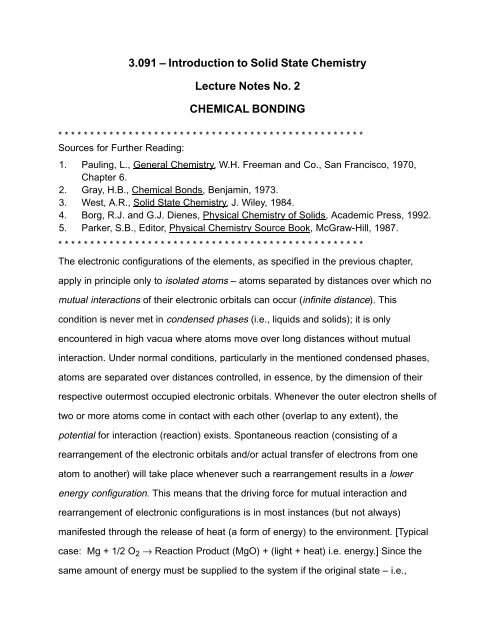
![18.03 Class 21, April 3 Fun with Fourier series [1] If f(t) is any decent ...](https://img.yumpu.com/51148985/1/190x245/1803-class-21-april-3-fun-with-fourier-series-1-if-ft-is-any-decent-.jpg?quality=85)

